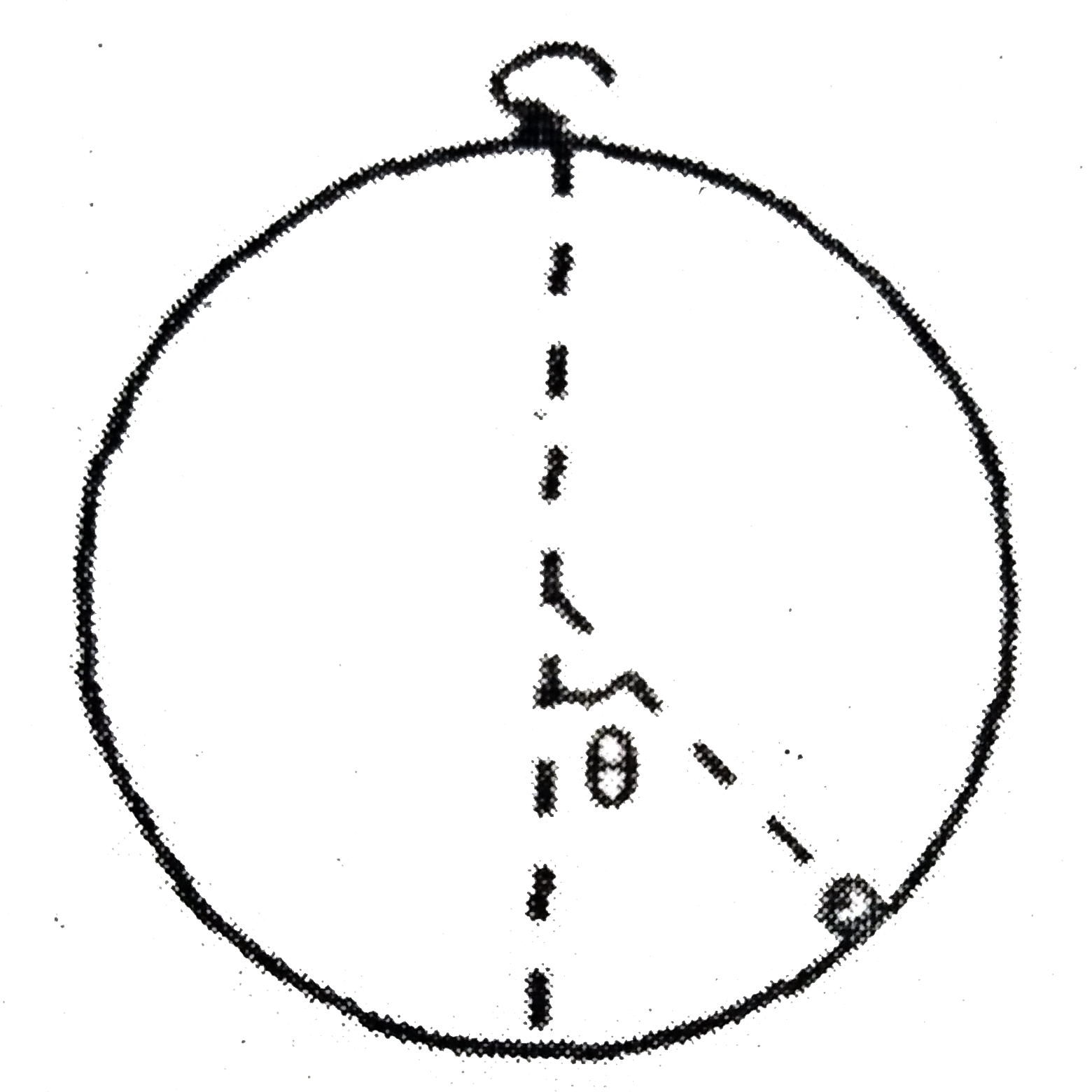A thin circular wire of radius R rotates about its vertical diameter with an angular frequency ω. Show that a small bead on the wire remain at its lowermost point for ω≤√g/R . What is angle made by the radius vector joining the center to the bead with the vertical downward direction for ω=√2g/R ? Neglect friction.
To solve the problem, we will break it down into two parts as stated in the question.
Part 1: Proving the Condition for the Bead to Remain at the Lowermost Point
1. Understanding the Forces Acting on the Bead:
- The bead is subjected to two forces: its weight mg acting downward and the normal force N exerted by the wire.
- The bead is also in circular motion due to the rotation of the wire.
2. Setting Up the Equations:
- At the lowermost point, the normal force N can be resolved into two components:
- Ncosθ (vertical component)
- Nsinθ (horizontal component)
- The vertical component must balance the weight of the bead:
Ncosθ=mg(1)
- The horizontal component provides the centripetal force required for circular motion:
Nsinθ=mrω2(2)
- Here, r is the radius of the circular path of the bead, which can be expressed as r=Rsinθ.
3. Substituting for r:
- Substitute r=Rsinθ into equation (2):
Nsinθ=m(Rsinθ)ω2
- This simplifies to:
N=mRω2(3)
4. Dividing Equation (1) by Equation (3):
- Dividing equation (1) by equation (3):
NcosθN=mgmRω2
- This simplifies to:
cosθ=gRω2
5. Finding the Condition for the Bead to Stay at the Lowermost Point:
- At the lowermost point, θ=0:
cos0=1⟹1=gRω2
- Rearranging gives:
ω2=gR⟹ω≤√gR
- Thus, we have shown that the bead remains at the lowermost point for ω≤√gR.
Part 2: Finding the Angle for ω=√2gR
1. Using the Relation for cosθ:
- We already have the relation:
cosθ=gRω2
- Now substitute ω=√2gR:
cosθ=gR(√2gR)2
- This simplifies to:
cosθ=gR⋅2gR=g2g=12
2. Finding the Angle θ:
- From cosθ=12, we find:
θ=60∘
Final Answers:
- The bead remains at the lowermost point for ω≤√gR.
- The angle made by the radius vector with the vertical downward direction for ω=√2gR is 60∘.
- The bead is subjected to two forces: its weight mg acting downward and the normal force N exerted by the wire.
- The bead is also in circular motion due to the rotation of the wire.
- At the lowermost point, the normal force N can be resolved into two components:
- Ncosθ (vertical component)
- Nsinθ (horizontal component)
- The vertical component must balance the weight of the bead:
Ncosθ=mg(1)
- The horizontal component provides the centripetal force required for circular motion:
Nsinθ=mrω2(2)
- Here, r is the radius of the circular path of the bead, which can be expressed as r=Rsinθ.
- Substitute r=Rsinθ into equation (2):
Nsinθ=m(Rsinθ)ω2
- This simplifies to:
N=mRω2(3)
- Dividing equation (1) by equation (3):
NcosθN=mgmRω2
- This simplifies to:
cosθ=gRω2
- At the lowermost point, θ=0:
cos0=1⟹1=gRω2
- Rearranging gives:
ω2=gR⟹ω≤√gR
- Thus, we have shown that the bead remains at the lowermost point for ω≤√gR.
- We already have the relation:
cosθ=gRω2
- Now substitute ω=√2gR:
cosθ=gR(√2gR)2
- This simplifies to:
cosθ=gR⋅2gR=g2g=12
- From cosθ=12, we find:
θ=60∘
- The bead remains at the lowermost point for ω≤√gR.
- The angle made by the radius vector with the vertical downward direction for ω=√2gR is 60∘.
Topper's Solved these Questions
Similar Questions
A thin circular wire of radius R rotatites about its vertical diameter with an angular frequency ω . Show that a small bead on the wire remain at its lowermost point for ω≤√g/R . What is angle made by the radius vector joining the centre to the bead with the vertical downward direction for ω=√2g/R ? Neglect friction.
View SolutionMoment of inertia of a circular wire of mass M and radius R about its diameter is
View Solution
Knowledge Check
A solid cylinder of mass M and radius R rotates about its axis with angular speed ω. Its rotational kinetic energy is
A12MR2ω2BMR2ω2C14MR2ω2D18MR2ω2
A spherical bowl of radius R rotates about the verical diameter with angular velocity ω.The bowl contains a small object inside and in absence of friction, this object takes up a position inside the bowl such that its radius vector makes an angle θ with the vertical (see figure). Then

View SolutionA ring of radius r is rotating about a vertical axis along its diameter with constant angular velocity ω.A read of mass m remains at rest w.r.t. ring at the position shown in figure. Then w2 is:
_2019_CBT8_E01_015_Q01.png)
View SolutionA ring of radius r is rotating about a vertical axis along its diameter with constant angular velocity ω.A read of mass m remains at rest w.r.t. ring at the position shown in figure. Then w2 is:
_2019_CBT8_E01_015_Q01.png)
View SolutionA thin circular ring of mass M and radius r is rotating about its axis with an angular speed ω. Two particles having mass m each are now attached at diametrically opposite points. The angular speed of the ring will become
View SolutionA thin circular ring of mass M and radius r is rotating about its axis with an angular speed ω. Two particles having mass m each are now attached at diametrically opposite points. The angular speed of the ring will become
View SolutionA thin circular ring of mass M and radius R is rotating about its axis with an angular speed ω0 two particles each of mass m are now attached at diametrically opposite points. Find new angular speed of the ring.
View SolutionA thin circular ring of mass M and radius R is rotating about its axis with constant angular velocity ω. The objects each of mass m are attached gently to the ring. The wheel now rotates with an angular velocity.
View Solution
